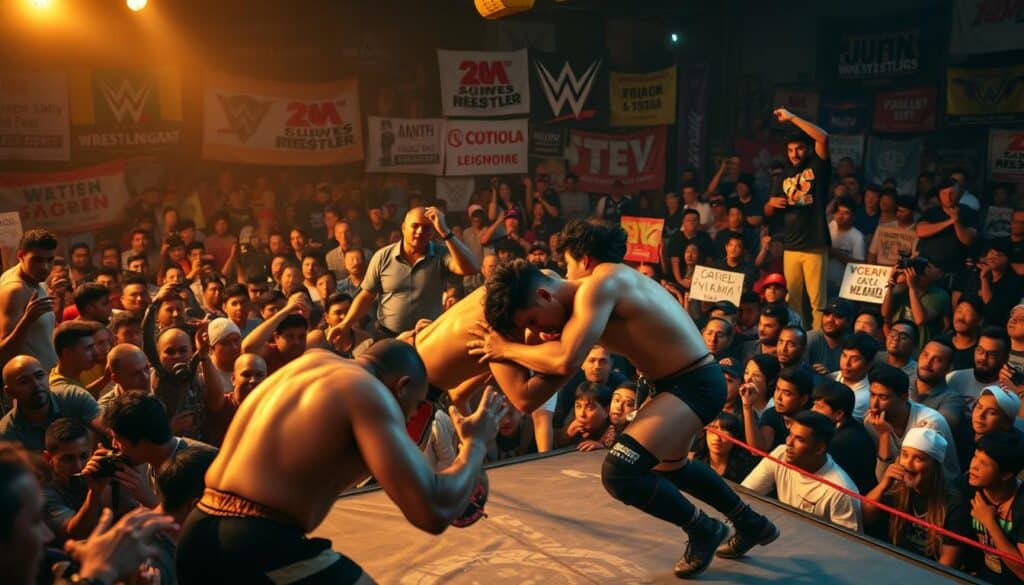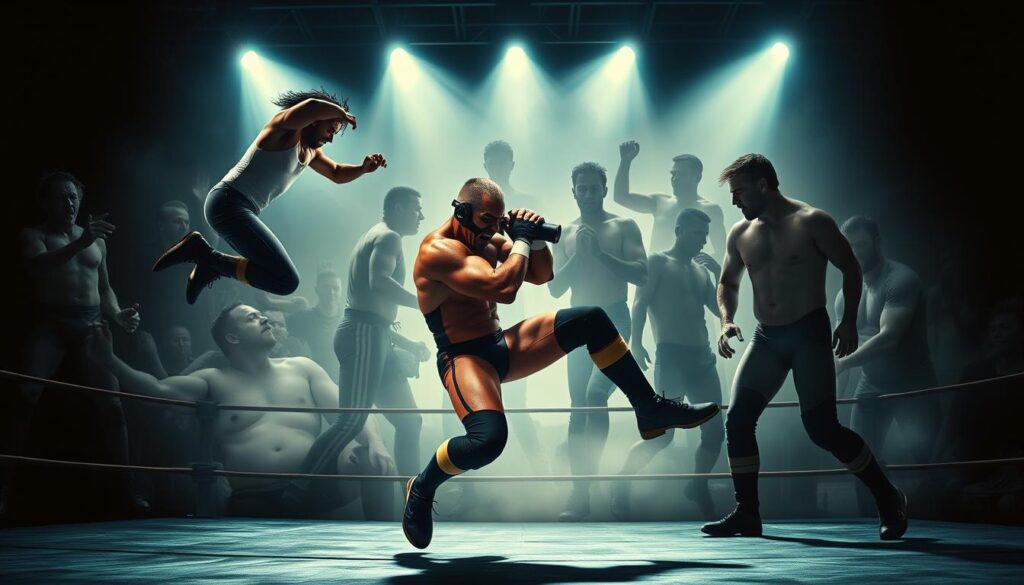In 1948, the National Wrestling Alliance took control, making every promotion bow to its belt. Fast forward to today, where 11,263 fans at All In cheered for Cody Rhodes’ moonsault. It was a big middle finger to tradition, loud enough to be heard from Saturn.
The NWA’s move led to wrestling’s “outlaw territories.” Think Harley Race as a Missouri cartel boss and Verne Gagne’s AWA as the Midwest’s Mad Max. These rebels showed that fans want stories that corporate bosses can’t script.
Today’s indie scene is all about the same energy as a punk show. It’s not just wrestling; it’s a cultural movement. The magic lies in how these uprisings shaped today’s wrestling.
Deadlock Pro’s pay-per-view model comes from Dusty Rhodes’ 1980s tactics. And that sold-out All In event? It showed that passion can beat out big money.
This isn’t just about body slams and folding chairs. It’s America’s battle between order and chaos, set to wrestling’s rhythm. Are you ready to see how yesterday’s rebels shaped today’s wrestling? Let’s walk the aisle.
The Diversity and Range of Independent Promotions
Mainstream wrestling is like a polished arena rock concert. Indie promotions are the underground punk shows where creativity and passion shine. These groups don’t just fill gaps; they are the heart of wrestling for those who love raw talent. Let’s look at five iconic promotions that have changed what “alternative wrestling” means.
ROH: Where Technical Mastery Meets Punk Rock Swagger
Ring of Honor is more than a promotion; it’s a school for wrestlers. Founded in 2002, it’s where future stars like AEW and WWE honed their skills. CM Punk’s “Summer of Punk” started here, bringing authenticity to the ring.
GCW: Deathmatch Alchemy as Performance Art
Game Changer Wrestling is like ECW on steroids. Their shows feature extreme matches with fans cheering on the action. It’s not just violence; it’s deathmatch poetry by wrestlers who’d bleed for their craft.
CMLL: Lucha Libre’s Living Museum
While WWE uses luchadores as novelties, Consejo Mundial de Lucha Libre has kept Mexico’s wrestling alive for 88 years. Their legacy includes the famous Atlantis vs. Villano III match, a cultural hit in Mexico. AEW’s high-flying style owes a lot to CMLL.
MLW: The Sports Illustrated of Wrestling
Major League Wrestling is like ESPN’s wrestling show. With a focus on sports and real storylines, MLW’s Fusion episodes feel like documentaries. Their partnership with AAA brings lucha libre to new fans.
TNA: Wrestling’s Most Fascinating Identity Crisis
Before becoming Impact Wrestling, TNA was caught between being indie and WWE-like. Their “WWE-lite” phase included the infamous electrified cage match. Yet, it also launched AJ Styles’ career, proving even mistakes can create legends.
| Promotion | Signature Style | Cultural Impact | Legacy Moment |
|---|---|---|---|
| ROH | Technical wrestling purism | Pipeline to mainstream success | Bryan Danielson’s 60-minute iron man match |
| GCW | Extreme deathmatches | Counterculture movement leader | Nick Gage’s “MDK All Day” viral chant |
| CMLL | Traditional lucha libre | Guardian of Mexican heritage | 1991 Atlantis vs. Villano III mask match |
| MLW | Sports-based presentation | Bridging US/Mexico styles | 2022 Azteca Underground storyline |
| TNA | Hybrid sports-entertainment | Proving ground for future stars | AJ Styles’ 2005-06 NWA title reign |
The trailblazers who paved the way are not forgotten. The WWA made history in 1963 with Bearcat Wright, the first Black world champion. Today’s promotions carry this rebellious spirit, constantly pushing the limits of what wrestling can be.
Influence on the Wrestling Scene
Joey Janela’s light tube incident at All In 2018 was more than just a bloody moment. It showed how underground wrestling is key to the sport’s growth. Legendary wrestlers test new ideas here, shaping the future of wrestling.
Kenny Omega’s 2017 match with Penta El Zero M was a game-changer. It showed how narrative violence can change the game. This match set a new standard for main events.
The world of wrestling changes fast today. What was once banned is now a key part of WWE’s shows. GCW’s extreme style has influenced Jon Moxley’s AEW character. This shows how niche ideas can become big hits.
Cross-promotional partnerships between NXT and TNA are exciting. They blur the lines between companies, making wrestling more interesting.
Okada vs Marty Scurll’s 2017 match was groundbreaking. It mixed British and Japanese styles, creating a new standard for dream matches. This match showed that indie wrestling is more than just entertainment; it’s a way to test new ideas.
The wrestling world is in a constant creative battle. This battle has blurred the lines between indie wrestlers and those in big companies. What’s next? Maybe something involving thumbtacks and streaming services.
Comparison: How Indies Stack Up Against Major Promotions
Corporate wrestling sells $12 nachos, but underground scenes offer $35 meet-and-greets. These meet-and-greets might let you meet a wrestler who remembers your name the next day. It’s not just about money; it’s a fight over how wrestling is seen.
WWE’s shows feel like scripted Marvel movies. But smaller groups create stories so unique, they might make Brooklyn artists jealous. Imagine a wrestler talking about healthcare while doing a 450 splash. That’s not chaos; it’s freedom in action.
Indie shows live in the shadows, funded by fans’ $20 handshakes. They help wrestlers pay for therapy. It’s like WrestleMania meets Burning Man, with wrestling moves instead of fire.
But here’s a tough question: Is selling out okay if it pays for health insurance? When AEW talks about WWE-style contracts, they’re not just talking money. They’re deciding if wrestling stays true to its roots or becomes just another show.
Independent Promotions from a Business Perspective
Let’s get real. That $14.99 you spent on DEADLOCK’s stream? It’s all profit for them. WWE’s Peacock earnings are peanuts compared to what indies make. Promoters pay AEW midcarders $750, while local stars like Lucky Ali get paid just $150. It’s not wrestling; it’s financial judo.
Source 1’s All In numbers show the truth: $1M gates aren’t about full arenas anymore. They’re content farming for big promotions. It’s like combining 1966 WWA Japan tours with TikTok’s algorithms. Why spend on pyro when talent sharing lets you outsource your main event to YouTube?
Sponsorship deals are now like Netflix – targeted and short-lived. Local car dealerships partner with wrestlers, not promotions. Ticket sales are just the start. The real money is in scouting talent for corporate wrestling. You’re not buying a seat; you’re funding auditions for TV.
Next time you watch an indie show, think: Are we seeing sport… or subcontracting? The answer might surprise even Vince McMahon.
The Independent Wrestling Revolution You’re Already Watching
What if the future of wrestling isn’t on TV? The indies are changing the game through digital platforms. They turn Twitch streams into big events and YouTube clips into hits. When Deadlock Pro-Wrestling teams up with DragonGate in Tokyo or GCW sells out in Denver, it shows global partnerships are key. They help indies thrive in a world where WWE’s influence is huge.
Today’s wrestlers skip the old ways and go straight to the top. Why wait for WWE’s Performance Center when West Coast Pro can sign you through YouTube? The numbers show: 70% of AEW’s wrestlers started on indies. Stardom’s women outsell Raw’s in merchandise. Indies are where wrestlers stay creative and fans see tomorrow’s stars up close.
Picture CMLL wrestlers in NJPW’s G1 Climax and TNA showing RevPro’s best on AXS TV. The difference between indie and major is fading fast. With streaming deals and big matches, the question isn’t if indies will beat WWE. It’s why they’re seen as underdogs anymore.


